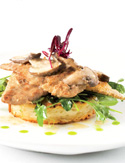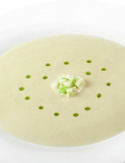This is from Oprah.com. There's a Vegan chef who is told to be AMAZING, and has a new book out: The first one seems a little more expensive and some of the ingredients may be hard to find depending on where you are, however it looks and sounds delish. If any of you try it, let us know!


Photo: Linda Long
Here are two of the recipes from his book.
Gardein Chicken Scaloppini
Udon Noodle Cakes:
Place a large sauté pan over high heat. Sprinkle the bottom with a pinch of salt and heat for 1 minute. Add the oil and heat for 30 seconds, being careful not to let it smoke. This will create a nonstick effect.
Add the noodle cakes and fry until browned and crisp on both sides, seasoning with salt and pepper as they cook, about 3 minutes per side. Remove to a paper-towel-lined baking sheet and put in the oven to keep warm.
To make the "chicken": Flatten the Gardein breasts with your hand to 1/2 inch thick, then cut each into 3 pieces. Season with salt and pepper, then dredge in the flour.
Wipe out the pan you used for the noodle cakes, and add 2 tablespoons of the oil. Heat over medium heat, then add the Gardein pieces and cook until browned, about 3 minutes on each side. Remove to a plate and set aside.
Add the remaining 2 tablespoons oil, heat over medium heat, then add the mushrooms and cook for 3 to 4 minutes, stirring often, until softened. Deglaze the pan with the sake and cook until reduced by half, 2 to 3 minutes. Add the stock and cook for 2 more minutes.
Remove from the heat and whisk in the Earth Balance 1 tablespoon at a time, whisking constantly so that the sauce doesn't separate. Stir in the chives. Return the Gardein to the pan and toss to coat it with the sauce. Cover to keep warm while you make the pea shoots.
To make the pea shoots: Place a medium sauté pan over medium heat. Sprinkle the bottom with a pinch of salt and heat for 1 minute. Add the oil and heat for 30 seconds, being careful not to let it smoke.
Add the garlic and sauté for 30 seconds. Add the stock and pea shoots and sauté for 3 to 5 minutes, until wilted. Drain the excess liquid.
To assemble the dish: Place a noodle cake in the center of each plate. Top each cake with a spoonful of pea shoots, then top the pea shoots with 3 pieces of the Gardein. Spoon a little of the sake and mushroom sauce over the Gardein and drizzle it around the plate. Garnish with microgreens and serve immediately.
CELERY ROOT SOUP
Here are two of the recipes from his book.
Gardein Chicken Scaloppini
This is a mash-up of my French and Japanese influences, with a very American meat-and-pasta sensibility. "Scaloppini" refers, of course, to a thin cut of meat, which here is Gardein, a vegan substitute that's a great transitional food for meat-eaters. Instead of European wine, this sauce calls for sake, and shiitakes are swapped in for traditional button mushrooms. The udon noodle cakes and pea shoots are another Asian touch, but the overall complexity and lushness of the dish give it a French feel.
Watch Chef Tal prepare his Gardein Chicken Scaloppini
Watch Chef Tal prepare his Gardein Chicken Scaloppini
Ingredients:
Serves 4Udon Noodle Cakes:
- 4 packs (7-ounce single-servings) precooked udon noodles , still in their packages
- Sea salt
- 2 Tbsp. extra-virgin olive oil
- Freshly ground black pepper
- Pinch sea salt
- 1 Tbsp. sesame oil
- 2 cloves garlic , minced
- 1/2 cup faux chicken stock
- 2 cups packed pea shoots
- 4 Gardein breasts
- Sea salt
- Freshly ground black pepper
- 1/4 cup unbleached all-purpose flour
- 4 Tbsp. extra-virgin olive oil
- 1 pound shiitake mushrooms , stemmed and cut into 1/4-inch slices
- 1 cup dry sake
- 1/2 cup faux chicken stock
- 1/2 cup Earth Balance (butter substitute)
- 1 Tbsp. minced fresh chives
- Microgreens to garnish
Place a large sauté pan over high heat. Sprinkle the bottom with a pinch of salt and heat for 1 minute. Add the oil and heat for 30 seconds, being careful not to let it smoke. This will create a nonstick effect.
Add the noodle cakes and fry until browned and crisp on both sides, seasoning with salt and pepper as they cook, about 3 minutes per side. Remove to a paper-towel-lined baking sheet and put in the oven to keep warm.
To make the "chicken": Flatten the Gardein breasts with your hand to 1/2 inch thick, then cut each into 3 pieces. Season with salt and pepper, then dredge in the flour.
Wipe out the pan you used for the noodle cakes, and add 2 tablespoons of the oil. Heat over medium heat, then add the Gardein pieces and cook until browned, about 3 minutes on each side. Remove to a plate and set aside.
Add the remaining 2 tablespoons oil, heat over medium heat, then add the mushrooms and cook for 3 to 4 minutes, stirring often, until softened. Deglaze the pan with the sake and cook until reduced by half, 2 to 3 minutes. Add the stock and cook for 2 more minutes.
Remove from the heat and whisk in the Earth Balance 1 tablespoon at a time, whisking constantly so that the sauce doesn't separate. Stir in the chives. Return the Gardein to the pan and toss to coat it with the sauce. Cover to keep warm while you make the pea shoots.
To make the pea shoots: Place a medium sauté pan over medium heat. Sprinkle the bottom with a pinch of salt and heat for 1 minute. Add the oil and heat for 30 seconds, being careful not to let it smoke.
Add the garlic and sauté for 30 seconds. Add the stock and pea shoots and sauté for 3 to 5 minutes, until wilted. Drain the excess liquid.
To assemble the dish: Place a noodle cake in the center of each plate. Top each cake with a spoonful of pea shoots, then top the pea shoots with 3 pieces of the Gardein. Spoon a little of the sake and mushroom sauce over the Gardein and drizzle it around the plate. Garnish with microgreens and serve immediately.
CELERY ROOT SOUP
Photo: Linda Long
This is the most popular soup I make—people go crazy for it. I first made it for a supper club I started at my friend Ko's jazz place in L.A. Throwing in some diced apple at the end adds a surprise tartness, and dots of chive oil give it a sleek, dramatic finish.
Ingredients:
Serves 6- Sea salt
- 3 Tbsp. extra-virgin olive oil
- 2 medium celery roots , peeled and cut into 1-inch cubes
- 2 stalks celery , chopped
- 1 large onion , chopped
- 2 quarts faux chicken or vegetable broth (try Better than Bouillon brand)
- 1 bay leaf
- 1 cup thick Cashew Cream
- Freshly ground black pepper
- 1 unpeeled Granny Smith apple , very finely diced
- Chive oil
Add the celery root, celery, and onion and sauté for 6 to 10 minutes, stirring often, until soft but not brown. Add the stock and bay leaf, bring to a boil, then reduce the heat and simmer for 30 minutes. Add the Cashew Cream and simmer for an additional 10 minutes.
Working in batches, pour the soup into a blender, cover the lid with a towel (the hot liquid tends to erupt), and blend on high. Season with salt and pepper to taste. Ladle into bowls. Place a spoonful of the diced apple in the center of each serving, drizzle the Chive Oil around the apple, and serve.
Cashew Cream
Cashew cream is a vegan-chef staple that stands in for dairy in a variety of ways.
In the raw-food world, where it originated, it's used in lots of desserts. When you cook with it, though, it can be so much more—from cheese filling in ravioli to heavy cream in soups. It can be stored 2 to 3 days in the refrigerator and can be frozen for up to 6 months (although after it's defrosted it can be a bit lumpy, so it's good to give it a spin in the blender to smooth it out before using it).
The trick when making cashew cream is to use raw cashews. They have no flavor of their own; they're just a vessel for fat and creaminess. (It's the roasting that brings out the familiar sweetness in cashews.) Because it has a nice fat content, cashew cream reduces in a pan even faster than heavy cream. (Soy milk, which some people use in vegan cooking, has no fat, so it doesn't reduce into a thick sauce—it's really not an alternative.)
In the raw-food world, where it originated, it's used in lots of desserts. When you cook with it, though, it can be so much more—from cheese filling in ravioli to heavy cream in soups. It can be stored 2 to 3 days in the refrigerator and can be frozen for up to 6 months (although after it's defrosted it can be a bit lumpy, so it's good to give it a spin in the blender to smooth it out before using it).
The trick when making cashew cream is to use raw cashews. They have no flavor of their own; they're just a vessel for fat and creaminess. (It's the roasting that brings out the familiar sweetness in cashews.) Because it has a nice fat content, cashew cream reduces in a pan even faster than heavy cream. (Soy milk, which some people use in vegan cooking, has no fat, so it doesn't reduce into a thick sauce—it's really not an alternative.)
Ingredients:
Makes about 2 1/4 cups thick cream or 3 1/2 cups regular cream- 2 cups whole raw cashews (not pieces, which are often dry), rinsed very well under cold water
Drain the cashews and rinse under cold water. Place in a blender with enough fresh cold water to cover them by 1 inch. Blend on high for several minutes until very smooth. (If you're not using a professional high-speed blender such as a Vita-Mix, which creates an ultra-smooth cream, strain the cashew cream through a fine-mesh sieve.)
To make thick cashew cream, which some of the recipes in this book call for, simply reduce the amount of water in the blender, so that the water just covers the cashews.
Chive Oil
Dots of Chive Oil, featured in Chef Tal's book The Conscious Cook, give dishes like Celery Root Soup a sleek, dramatic finish.
Ingredients:
Makes 1/2 cup- 1 small bunch chives
- 1/2 cup canola oil
- Pinch sea salt
- Freshly ground pepper
Blanch the chives for 30 seconds in boiling water, then drain and chill in an ice bath. Drain, wrap the chives in a towel, and squeeze the moisture out. Place in a blender with the remaining ingredients and blend for 2 minutes. Strain through a fine-mesh sieve. Put the chive oil in a plastic squeeze bottle with a small opening or use a spoon for drizzling it on the soup.











